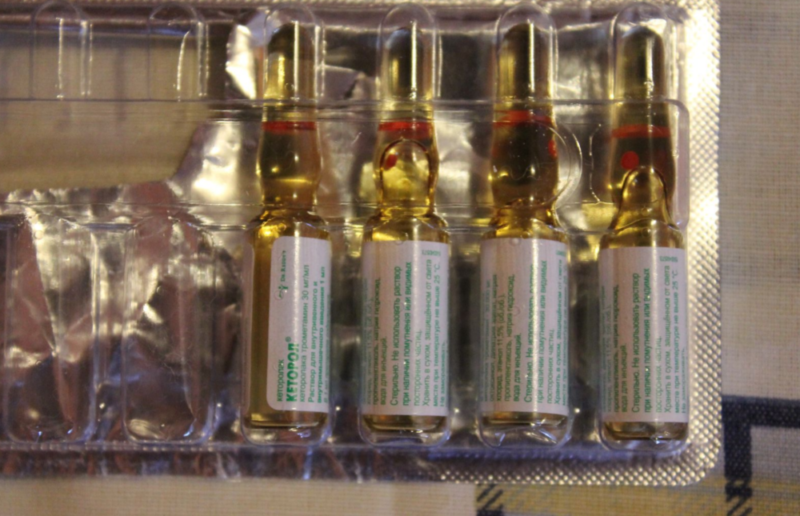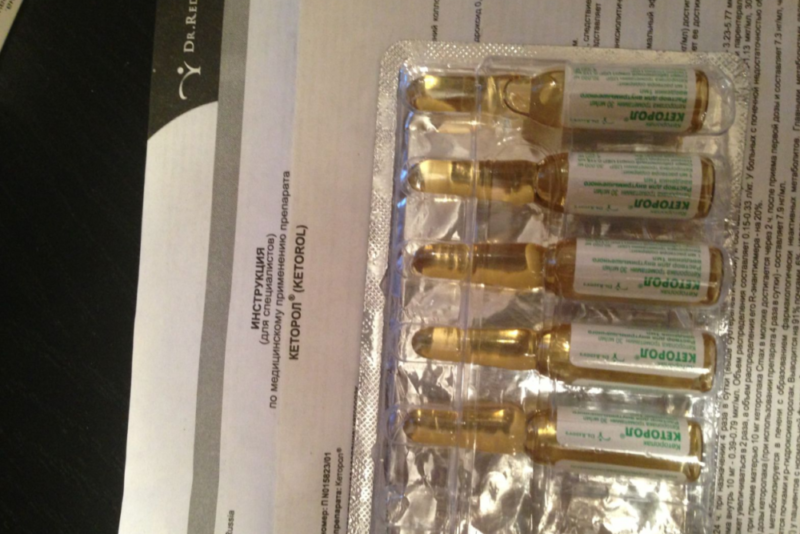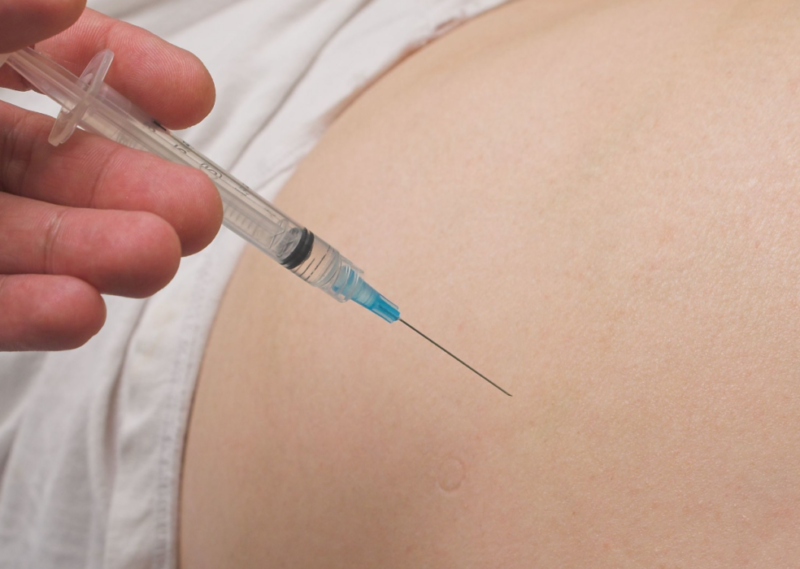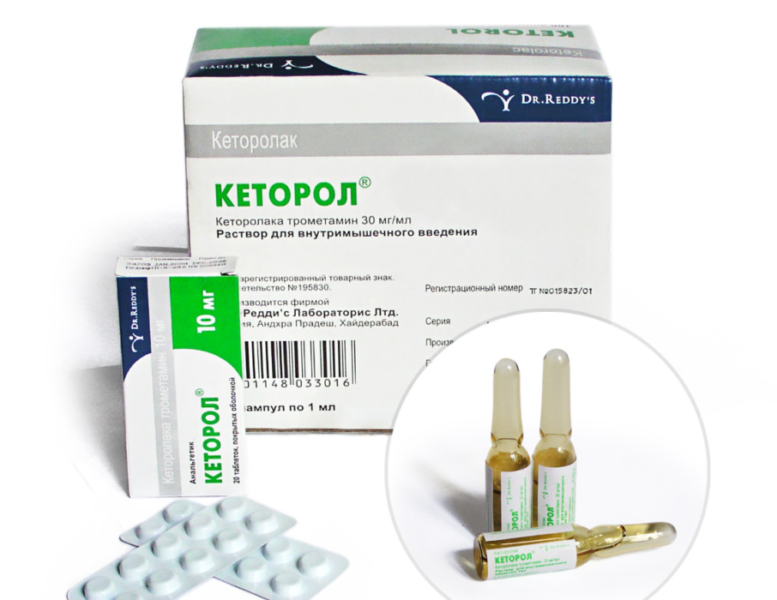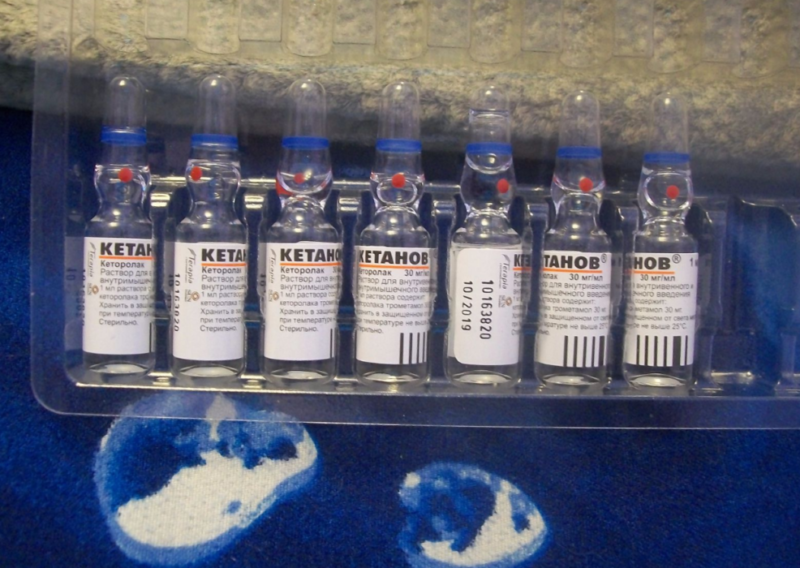Injuries, inflammatory processes and various pathologies are usually accompanied by severe pain. To eliminate them and alleviate the condition of the patient, doctors prescribe a number of non-steroid drugs. Ketorol, injections of which are indicated for various neuralgia, not only stops the pain, but also stops the inflammatory process.
Material Content:
The composition of the drug
Ketorol is a derivative of acetic acid and, by its chemical nature, this medicine belongs to the group of non-hormonal painkillers. The drug was first released in the 1980s as anesthetic injections for various neuralgia. It is produced as a solution for injections (into a muscle and into a vein), has the appearance of a clear or yellowish odorless liquid.
Only 1 ml ampoules are on sale, which contain:
- active ingredient - 30 mg of ketorolac tromethamine;
- additional ingredients - octoxynol, disodium edetate, sodium chloride, ethanol, propylene glycol;
- water in the amount necessary to fill the ampoule up to 1 ml.
Ketorol is sold in standard cardboard packs; each of them has a paper instruction leaflet. The medicine is dispensed only as prescribed by the doctor, it is not freely available.
Pharmacological properties and pharmacokinetics
Ketorol is an anti-inflammatory drug (NSAID) that does not have a sedative or hypnotic effect and does not cause dependence or breathing problems, unlike opiate drugs.
The medication has several actions at once:
- lowers temperature;
- stops pain;
- reduces the focus of inflammation.
Its analgesic effect is due to the ability to inhibit physiological lipid substances (prostaglandins), which are located in all tissues of the body and are responsible for the sensitivity of nerve endings. Thanks to these substances, modulation of pain and inflammatory processes in the body occurs, which cease under the influence of Ketorol.
The injection form of the drug provides an almost instantaneous entry into the bloodstream, where it is completely absorbed and anesthetizes:
- with intramuscular administration in half an hour;
- with intravenous - after 10 minutes.
The maximum effect falls on 1-2 hours after the injection, and its therapeutic effect lasts for 5 hours. The drug is metabolized in the liver, disintegrating into simple components - glucuronides, which are completely excreted in 10-15 hours along with urine and feces.
What Ketorol injections help
Ketorol has a pronounced analgesic effect, while its antipyretic functions are less effective in comparison with other NSAIDs. Ketorol injections are prescribed for pain of any nature and intensity.
Most often, injections are prescribed for the following ailments:
- injuries
- Toothache
- recovery after surgery;
- oncological and rheumatic diseases;
- burns of varying severity;
- colic in the liver and kidneys;
- pain in muscles, joints and peripheral nerves.
Ketorol helps to soothe pain, that is, it is used as a treatment for symptoms and does not affect the course and duration of the disease.
Instructions for use and dosage
The substance is injected intramuscularly (i / m) or intravenously (i / v), depending on the intensity of the pain and its duration.
The solution in ampoules does not need additional dilution, but the doses are selected by the doctor individually based on the intensity of the pain and other indicators:
- Patients 16-64 years old with a weight of more than 50 kg i / m are given up to 60 mg per injection (most often 30 mg every 6 hours), and iv - 30 mg (for 2 days there should not be more than 6 injections )
- Patients aged 18-64 years old with a weight of less than 50 kg / m are given up to 30 mg every 6 hours, and iv - 15 mg every 6 hours.
At the same time, the maximum dose of Ketorol per day for a patient weighing more than 50 kg cannot exceed 90 mg, and for people with a mass of less than 50 kg and an age exceeding 65 years, 60 mg. The course of treatment with these NSAIDs cannot be more than two days. If the doctor prescribed Ketorol injections intramuscularly, the drug should be injected slowly, deep into the soft tissues, but when injected into a vein, on the contrary, in less than 15 seconds.
During pregnancy and lactation
Ketorolac can penetrate histological barriers - about 10% of its total amount in a woman’s body passes through the placenta into the amniotic fluid and from there into the emerging embryo organism. It is strictly forbidden to use the medication for women in a position, especially in the first trimester. The use of this medication can only be allowed if the benefit to the mother significantly exceeds the potential harm to the child.
Ketorolac passes into breast milk and may thereby cause irreparable harm to the baby. When used by a nursing mother, 10 mg of the drug after 2 hours, about 7.3 ng / ml will be in breast milk, which is the maximum concentration. If the appointment of Ketorol is necessary for a nursing woman, at the time of use and excretion of the substance from the body, the baby's nutrition should be replaced with an artificial mixture.
Compatible with other medicines and alcohol.
Ketorol injections should not be used at the same time as taking other non-hormonal anti-inflammatory drugs, as this can lead to bleeding in the digestive tract.
Negative manifestations can also cause the joint appointment of Ketorol and the following medicines:
- Paracetamol or methotrexate - increases nephrotoxicity;
- Insulin - increases the glycemic effect of the latter;
- Antacid preparations - reduce the absorption and effectiveness of Ketorol;
- Anticoagulants, heparin, thrombolytics - there is a risk of bleeding.
Taking the medication affects concentration and attentiveness, so you should refrain from driving vehicles or working with heavy machinery for the duration of treatment.
The use of alcohol during treatment is also unacceptable - ethanol not only reduces the susceptibility of nerve endings to the action of the drug, but can also provoke a number of serious side effects.
Contraindications, side effects and overdose
Since Ketorol does not belong to the opiate group, it can be taken without the risk of developing addiction. Replacement with another pain medication is indicated if the patient is allergic to ketorolac or other components of the solution.
In addition, contraindications are also:
- intolerance to aspirin;
- asthma of any kind or polyposis in the paranasal sinuses;
- ulcerative lesions of the gastrointestinal mucosa;
- bleeding;
- acute exacerbations of inflammation in the intestine;
- coagulation dysfunction;
- heart, liver, or kidney failure.
Ketorol is prohibited to use before or during surgery, as well as during the recovery period after bypass surgery. It is not indicated for pregnant, lactating women and children under 18 years of age.
With caution, the medicine should be prescribed to patients in whom:
- coronary heart disease;
- edematous syndrome;
- diabetes.
Ketorol has injections and side effects in the form of nausea and diarrhea, lower back pain, acute renal failure, swelling, rhinitis and dizziness. An allergic reaction is manifested by skin rashes, itching and indigestion.
If the doctor’s instructions are not followed, the patient may begin to overdose, the symptoms of which are vomiting, ulcerative lesions of the gastrointestinal tract, impaired renal function. Treatment includes gastric lavage and symptomatic therapy.
Analogs
The main analogue of injections are Ketorol tablets, which have the same therapeutic features, but are more convenient to use, especially if the patient is on outpatient treatment.
Among the structural analogues are:
- Adolor;
- Dolak;
- Dolomin;
- Ketanov;
- Toradol.
Replacement of Ketorol with any synonym is made with the permission and under the supervision of the attending physician, if the patient has a number of contraindications for admission.
Ketorol in ampoules is an effective and fast-acting analgesic that relieves even severe pain. The course of treatment leads to a decrease in pain and significantly reduces the focus of inflammation, which allows the body to quickly cope with the disease.


